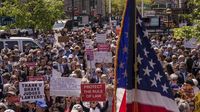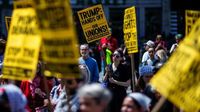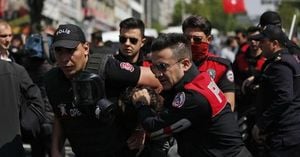On May 1, 2025, May Day, also known as International Workers Day, was marked by rallies across the United States and around the world, uniting thousands in a collective outcry against President Donald Trump's administration. This year's demonstrations were framed as a strong pushback against what many see as an assault on labor protections, immigrant rights, and federal employees.
In New York City, over a thousand protesters gathered at Foley Square, just steps away from City Hall, before marching around the block. The atmosphere was charged with energy as demonstrators expressed their determination to stand up for their rights. "Right now, we're seeing workers across the board attacked, be it our federal workers, our brothers and sisters in labor, or immigrant workers," said Murad Awawdeh, president and CEO of the New York Immigration Coalition. "We're standing here together, and we're not going to take this fight sitting down. All our communities deserve dignity and respect."
Among the speakers was Rep. Alexandria Ocasio-Cortez, who surprised the crowd with a brief address in support of labor policies and immigrant rights. She criticized the Trump administration's recent policies, asserting, "When they see us gather in the streets, Washington politicians get very afraid." Ocasio-Cortez's remarks resonated with the crowd, who chanted slogans calling for justice and workers' rights.
As the protests unfolded in New York, similar demonstrations took place in cities like Chicago, Los Angeles, and Philadelphia, where activists rallied against the administration's aggressive immigration policies and cuts to federal jobs. In Chicago, thousands marched through downtown, with a diverse crowd that included union workers, immigrant rights advocates, and pro-Palestinian activists. "We need to stand up and fight back," said Latrina Barnes, a certified nurse's assistant, who participated for the first time due to concerns over Medicaid and Medicare cuts.
The protests were part of a broader movement known as the "50501" initiative, which aims to unite various causes under the banner of upholding the Constitution and ending executive overreach. The movement originated from a Reddit forum launched earlier in the year and has seen significant grassroots mobilization since Trump's inauguration.
In Los Angeles, thousands of demonstrators marched with signs proclaiming messages of solidarity, such as "Immigrants make America great" and "It's not the time to be silent." April Verrett, president of the Service Employees International Union, emphasized the need for unity among workers, stating, "We’re bringing the fight to the billionaires and politicians who are trying to divide us with fear and lies."
Atlanta's protests featured retired employees from the U.S. Centers for Disease Control and Prevention (CDC), who expressed concerns over impending job cuts. Deblina Datta, a former CDC worker, stated, "We really want to stand up for all of our fellow laborers who were laid off or just fired with no real reason. Without the CDC, bad things will happen."
Across the nation, the protests were not just limited to labor rights but also addressed broader issues of social justice. In New York City, a rally dubbed "National Rule of Law Day" was held by lawyers and their supporters, decrying what they described as the Trump administration's disregard for the legal system. Veronica Salama, a lawyer representing detained Columbia University student Mahmoud Khalil, remarked, "This is about all of us in the face of escalating repression. We recognize the interconnectedness of our struggles."
Internationally, May Day demonstrations echoed similar sentiments, with rallies in countries such as Japan, Greece, and the Philippines, where protesters rallied against Trump’s tariffs and immigration policies. In Europe, union leaders condemned the "Trumpization" of world politics, warning that rising anti-immigrant sentiment and extended workdays were dismantling labor protections.
The historical roots of May Day date back to the late 19th century when unions began advocating for an eight-hour workday. The day is now commemorated globally, with the Chicago Haymarket affair of 1886 serving as a pivotal moment in labor history. During that event, a deadly confrontation between police and labor activists led to the execution of several labor leaders, and their sacrifice is remembered every May 1.
As the protests continued, the mood was one of defiance and hope, with demonstrators uniting across various causes. In Washington, D.C., the wife of Kilmar Abrego Garcia, a man wrongfully deported to El Salvador, spoke to crowds, highlighting the personal impact of the administration's policies. "My husband was illegally detained, abducted and disappeared, thrown away to die in one of the most dangerous prisons in El Salvador with no due process because of an error," Jennifer Vasquez Sura said, as the crowd responded with chants of "shame."
With Trump's approval ratings at a historic low, the May Day protests signal a growing wave of dissent against his administration's policies. As activists from diverse backgrounds come together to demand change, the message remains clear: they will not stand idly by as their rights are trampled.
As the day came to a close, the energy of the protests lingered in the air, a testament to the collective will of the people to fight for their rights and the rights of others. The spirit of solidarity echoed through the streets, reminding everyone that the struggle for justice and equality is far from over.





